FOCUS USED TRUCK MARKEF
Page 43

If you've noticed an error in this article please click here to report it so we can fix it.
When you're shopping around for a used truck, do you take muc notice o it security features? Glass's Gui e's CV editor Geor e Alexander thinks ou should.
This could be the year when the issue of lorry theft and just how much the manufacturers are prepared to do about it becomes a hot topic. Car and van producers have long known the importance of crime prevention technology. Anti-theft features on vans have made a quantum leap Forward with high-security dead locking, alarm systems, unglazed rear doors, intelligent ignition keys, and various ways to permanently identify individual components.
The thieves seem capable of overcoming most security systems but will still target unprotected and "easy mode" vans if given the choice.
The manufacturers of several car-derived and panel vans should be congratulated on taking the initiative by beefing up. security. They should continue to protect their marques with even greater ingenuity. Hopefully, before long they will be joined by those who have not yet begun to take the security of their customers' property seriously. But what about the big boys? It seems that the huge losses suffered when such valuable vehicles and their loads go missing has not yet motivated many manufacturers to act. Options abound on dealer price lists, but it appears that the basic vehicle is all too vulnerable to theft.
If only for reasons of safety, it is impractical to create a cab that is a Fortress, but it should not be unrealistic to prevent it being driven away this easily. The high cost of the systems already available would quickly tumble if they became standardised at the point of truck production. The common objection to this is that operators prefer to specify their own security systems. But this can be dealt with in the same way as any other area of truck specification. Customer preference and experience should be researched along with the current best industry practice. This should result in security options which successfully deter crime becoming standard factory-fit items. A good start would be the addition of a First-class steering column lock and a choice of the most popular alarm systems, including tracking technology. Those truck builders who have taken a lead in this will be rewarded not only in customer satisfaction, but also in enhanced residuals. At present there is no clear premium paid for hecory security but that is likely to change with insurers ever more anxious to reward the prudent. This would certainly penalise the market value of any truck seen to be an easy target for thieves. Even if this argument does not convince those manufacturers who have not yet taken a stand, they have to listen to their customers. Professionalism should lead everyone in road transport to clobber the thief whenever possible, and to promote the positive side of the industry's image. Dealers should not underestimate the effect that the run-up to the next election will have on sales of commercial vehicles. It is likely that the best efforts of the Government will provide improving trading conditions for the customers of LCVs. The decision to replace a car-derived van is a relatively easy one and small business will be swayed by benefits filtering down from the recent Budget and interest rate changes, which will help to fuel the arrival of that long awaited "feel good factor". Such a simple reading of future economic prospects will not influence the big logistic companies whose Fleet spend runs into the millions. They simply cannot take buying decisions that fail to fully encompass business (and political) issues that are years ahead.
This explains why in 1992, when most pundits in the commercial vehicle world could see no sign of an upturn, the sales of new and used heavies took a sharp upward turn. And now, when the economy seems to be in good shape, decision makers attempting to predict market conditions at the end of the decade are understandably being cautious. A new Government, possibly tied to higher social spending and environmental policies that deter business investment, would dent any optimistic plan. We therefore expect sales of new and used lightweights to grow as the "lightweight political debate" accelerates towards the general election. Sales of used trucks will remain firm on a value-for-money basis while registrations of new heavy vehicles are at best expected to mark time. Although the trucks sales total of 52,000 is well below the 1989 figure, some observers believe that it is a true reflection of the sustainable size of the new market.




































































































